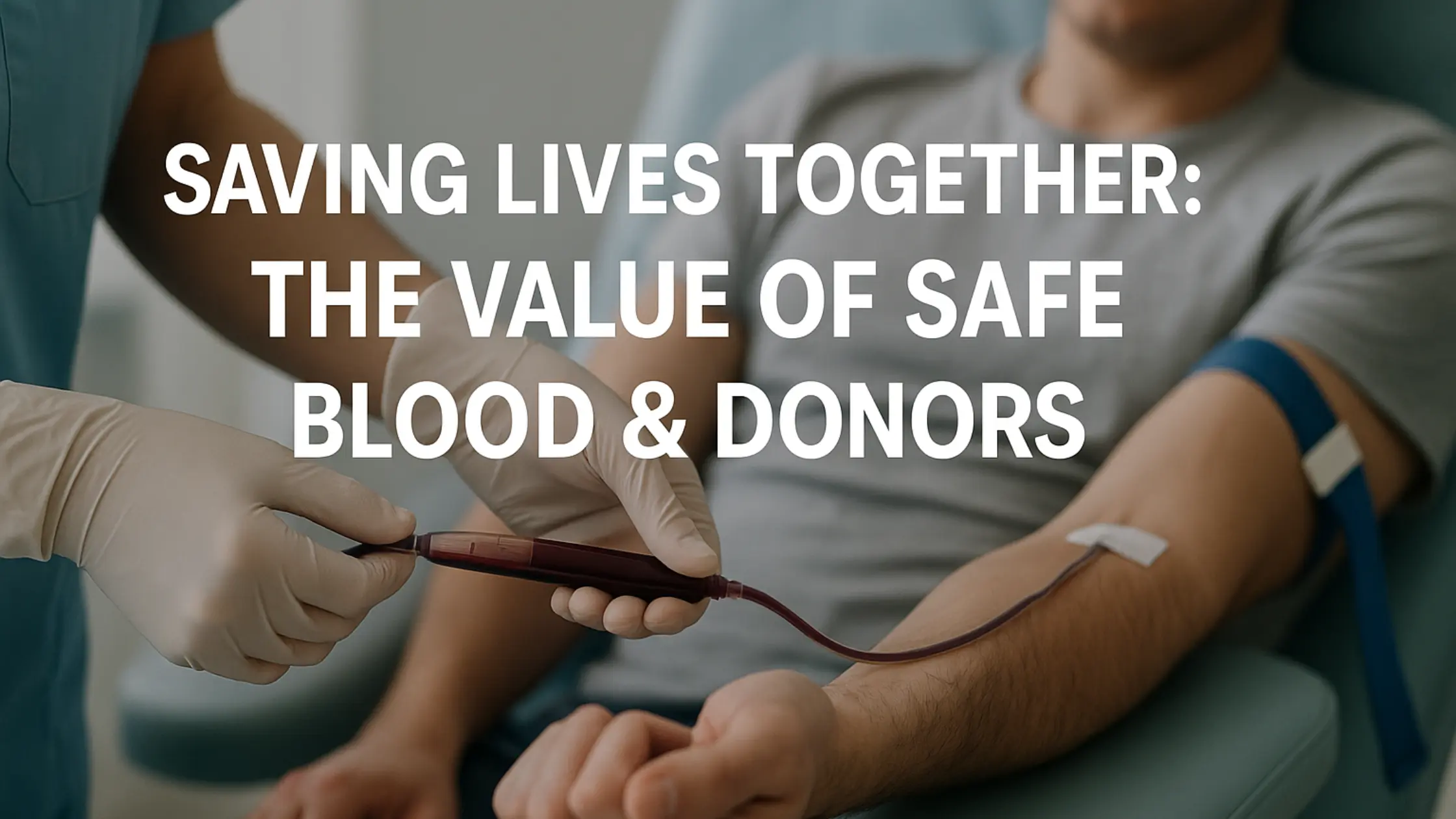Table of Contents
Toggle“You don’t have to be a doctor to save lives.” This powerful statement by Dr. Rinku Bhatia, Blood Bank Officer at Meenatai Thackeray Blood Centre in Mumbai, captures the very essence of voluntary blood donation. As we observed World Blood Donor Day on 14th June 2025, it was a moment to reflect, appreciate, and act in unison. The theme of the webinar, “Saving Lives Together: The Value of Safe Blood & Donors,” resonates deeply with the spirit of humanity and solidarity. It’s not just about the act of donating blood; it’s about offering hope, a second chance, and sometimes, life itself to those in need. Blood donation is more than an act of kindness; it’s a life-saving commitment.
Why – Blood Donation So Important?
Blood is a vital component that cannot be artificially manufactured. The only source is generous human donors. Hospitals and emergency services require a continuous and safe supply of blood to treat:
Just one pint of donated blood can save up to 7 lives, thanks to advanced techniques that allow separation into components like:
- Red Blood Cells – used for trauma, surgery, and anemia.
- Plasma – helps patients with clotting disorders and burns.
- Platelets – critical for cancer patients and those undergoing transplants.
- Cryoprecipitate – used in cases of massive bleeding or clotting factor deficiencies, like thalassemia and hemophilia
Many such patients depend on regular blood donation and transfusions. Yet, despite its importance, blood shortages are frequent, and many lives are lost due to the unavailability of this life-saving resource at the right time. Promoting it consistently is the only way to ensure that no life is lost due to a lack of access.
Who Can Donate Blood?
Not everyone is eligible to donate, and specific criteria ensure the safety of both donor and recipient. Key guidelines include:
- Age between 18 and 65 years
- Minimum weight of 50 kg
- Hemoglobin level of at least 12.5 g/dL
- General good health with no recent infections or surgeries
Pre-donation tips:
- Getting a good night’s sleep
- Having a light, healthy breakfast
- Wearing comfortable, loose clothing
- Staying hydrated
The gap between donations is crucial, 3 months for men and 4 months for women, to allow the body to replenish red blood cells. Following these guidelines helps keep blood donation both safe and sustainable.
What to Expect Once the Donation is Complete?
Donors are advised to:
- Rest for 10–15 minutes
- Have fluids and light snacks
- Avoid strenuous activities for the rest of the day
While rare, mild reactions like dizziness or nausea can occur, but usually resolve quickly with rest and hydration. The process of blood donation is quick, safe, and deeply rewarding for the donor.
Breaking the Myths
One of the major barriers to voluntary misinformation is the lack of awareness.
For instance:
Myth: Blood donation leads to weakness.
Fact: Healthy individuals can safely donate; the body quickly compensates for the loss.
Myth: You can contract infections by donating blood.
Fact: All equipment used is sterile and disposed of after a single use.
Dispelling such myths is essential to encourage more people to consider it a safe and selfless act.
Advanced Blood Donation Techniques
Apheresis: Beyond traditional whole blood donation, modern methods like apheresis allow for the targeted collection of specific components such as:
- Platelets (Plateletpheresis)
- Plasma (Plasmapheresis)
- White blood cells (Granulocytapheresis)
- Peripheral blood stem cells (PBSCs)
In this procedure, blood is drawn, separated by a machine, and the remaining components are returned to the donor. It’s safe and allows for more frequent donations. For example, platelets can be donated twice a month. These advanced methods of blood donation increase the availability of life-saving components for those in urgent need.
Ensuring Safe Transfusions
Before any transfusion, blood undergoes rigorous testing.
History:
- Testing for Hepatitis B and Syphilis began before 1988
- HIV testing became mandatory in 1988
- Hepatitis C testing began in 2001
- Developed countries adopted Nucleic Acid Testing (NAT) for early detection
- In 1996, India established the NBTC and SBTCs to regulate and improve blood banking nationwide. These milestones have greatly improved the safety and trust around the concept in India.
How Can You Get Involved?
Becoming a voluntary blood donor is easy and impactful. Whether it’s organizing camps, spreading awareness, or registering as a donor, every step counts. Because when you give blood, you give someone another birthday, another chance, another hope. Encouraging the idea behind donating blood in schools, colleges, and workplaces can build a healthier and more compassionate society.
निष्कर्ष
As Dr. Rinku Bhatia rightly said, the value of blood is truly priceless. It’s not just a unit of life; it’s a symbol of compassion, solidarity, and community. Let us celebrate World Blood Donor Day not just once a year, but every time we extend our arm to donate, knowing fully well that someone, somewhere, will live because of it. Let’s make blood donation a regular habit, not just on one day, but as a lifelong commitment to saving lives.



1 thought on “Saving Lives Together: The Value of Safe Blood & Donors”
Truly inspiring read! Blood donation is such a simple yet powerful act that can save multiple lives. I didn’t know one pint could help up to 7 people. The myth-busting section is very useful—more people should know it’s safe and vital. I’m motivated to donate regularly now!